
The fresh food movement is fur real as more and more pet parents are recognizing the amazing health benefits that can be derived from feeding dogs real, fresh foods. The time is coming when we will no longer think in terms of people food or dog food. Food is food is food, regardless of who is eating it!
It’s time to start putting conventional processed dog foods into the same category that we put conventional processed human foods. They are fine in moderation, but without real, fresh, nutrient-dense foods, the body will suffer. It’s not a questions of if, it’s a question of when and how badly. But we get it! Money is tight and time is even tighter. That’s why I’m going to share with you my strategy for incorporating fresh, whole foods into my dog’s diet FOR FREE.
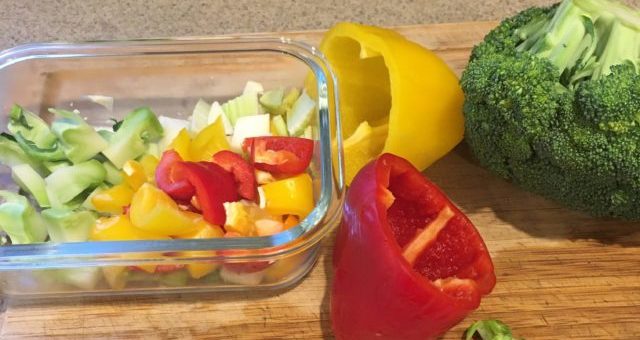
**Consult with your vet before making any changes to your dog’s diet.**
Getting the Greens without Extra Green
Okay, okay. I admit it. It is true that nothing in life is truly free. This will take a little bit of time and effort on your part. But take it from me. Once you get into the habit, you will only be investing a few extra moments of your time. Minutes, not hours. And once your dog starts zooming around like she is a puppy again, you get blinded by the shine on her coat, she stares at you with the brightest eyes you’ve ever seen, and your house suddenly has a lot less dog hair floating around, you’ll see that the tiny bit of extra time is well worth it. Not to mention, you will be reducing your dog’s risk of developing diseases, including cancer, by incorporating even just some fresh food in her diet.
Shooting For Balance
In our house we try to eat a healthy diet. I cook breakfast every morning and dinner for my family most nights of the week with a strong focus on fresh veggies and proteins. But don’t get me wrong. Friday night comes and I’m dipping into queso or ordering a pizza without the slightest hesitation. As it says on the wall of our favorite local Mexican joint: Some days you eat quinoa salad and run 5 miles. Some days you eat 5 tacos and drink margaritas. It’s called balance.
One day while I was scooping kibble into my best girl’s dish I had a flash. What if I aimed for that same balance in her diet? I was not prepared to go full-on fresh. I’m not a veterinary nutritionist and I needed kibble for convenience. But could I supplement her diet with fresh food, making it a lot more beneficial without much fuss or funds?

Using Fresh Fruits and Veggies as Treats
I started experimenting with fresh fruits and veggies. Of course, first I familiarized myself with foods that you should not feed your dog. In an effort to make her more healthy, I didn’t want to inadvertently make the girl sick. As I was chopping vegetables that I knew she could safely eat, I would let her try some.
I’d use little pieces of carrot or apple as treats. She loved them! The crunch, sweetness, and juice were very appealing and she wagged her tail eagerly when I’d offer them up. If I was tossing some blueberries into my yogurt, I’d give her a few. She gobbled them up with the same enthusiasm she’d show for beef! The more I experimented, the more I realized that she had a very diverse palate. I let her try and every safe veggie or fruit I was chopping for my family.
Tip: If your dog doesn’t like a fresh fruit or veggie on its own, try topping it with a spoonful of melted coconut oil!*
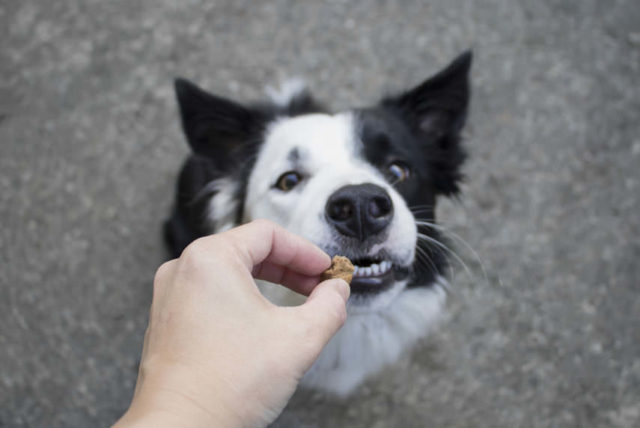
The Key to Free Fresh Food
I did not run out and start buying fresh fruits and veggies solely intended for my dog. Instead, I changed my perspective to one of reducing food waste (the Earth will thank me!) and maintaining my food budget. We live in a really cold climate so I make tons of soup in the fall and winter. I use veggie trimmings that I would have thrown out as bases for soup stocks. It occurred to me that I could put that same strategy to use in serving up fresh food for my dog.
American kitchens tend to generate lots of food waste. This costs us money and adds to the waste disposal problems we have in this country. The basic principle in feeding your dog for free is this: take those trimmings that you would normally throw away, and chop them up for your dog instead. I’m NOT suggesting you feed your dog the irrevocably dirty end of the celery bunch or that bruised up piece of apple you carved around. I’m suggesting you strategically chop up your veggies and fruits with the aim of eating what you normally would and salvaging the rest of the perfectly edible stems, roots, and leaves for your fur baby.
Day after day, I manage to add a heaping serving of fresh fruits and veggies to my dog’s dish at every meal without spending an extra dime at the grocery store.
Practical Tips
Bell Peppers: Cut the top off the bell pepper and discard the seeds and soft bits from the interior. Pick up the top and carefully remove the rounded tips that immediately surround the stem. Discard the stem and chop up the rest of the top. Use the bottom for yourself and chop the remaining top for your pup.
Broccoli or Cauliflower Stems: Cut the stem off the broccoli about 2-3 inches from the bottom of the stem. This bottom part is for your dog. Slice off the rough end and chop up the rest.
Celery: Cut the bottom and stop of the celery stalk. The middle long piece is yours. Trim off the very tips and chop up what remains for your dog’s dish.
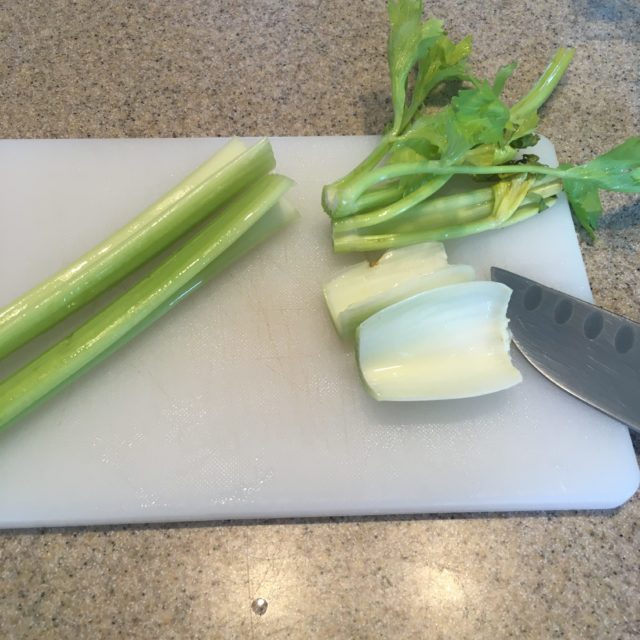
Apples or Pears: Slice chunks of pear or apple around the core. Take your knife and slice off thin pieces close to the core for your dog or simply cut off the top and bottom of the core and slice up what remains.
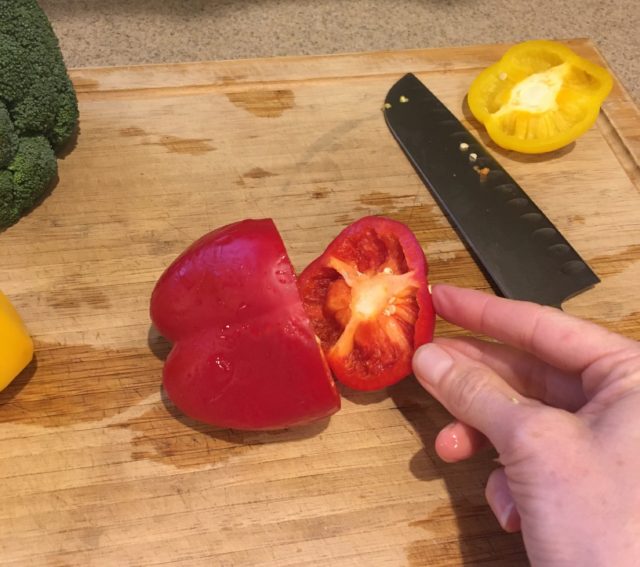
Green Beans: As you snip off the tips of green beans, save the ends for your dog. Trim off the stem and serve your dog the rest. Alternatively, grab a few whole green beans for her. You won’t miss them!
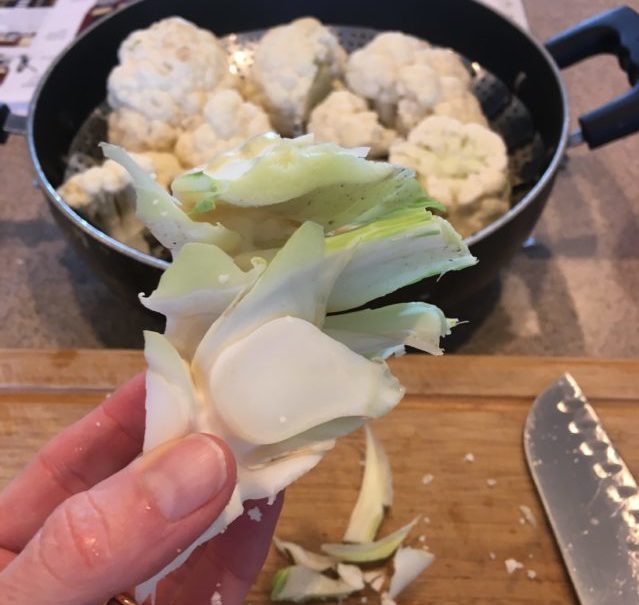
Asparagus: The ends of asparagus can be very fibrous and tough to eat. Cut your own spears a little bit shorter than usual and set them aside for yourself. Cut small pieces of what remains, discarding the last inch or so of tough ends.

I usually add chopped veggies to a container that I have for this purpose that I store in the fridge. Each day, I grab a handful or so from the mix and toss it in her bowl with kibble. Sometimes I serve it as a topper, sometimes I mix it in. If it has some items that she needs a little encouragement to eat, I add a spoonful of coconut oil* on it and mix it all up. There is never a single morsel left. She looks forward to each meal with its variety of tastes and textures.
The possibilities are nearly endless when it comes to incorporating fresh food into your dog’s diet. By changing your perspective to one of waste reduction and using more of what you already have on hand, you can generate a bountiful supply of health-improving fresh foods for your pup, without spending an extra dime.
Do you feed your dog fresh foods? What is your method for mixing in fresh foods?
*Remember: Coconut oil is a fat, and should be given sparingly.
The post Feed Your Dog Fresh Food For Free appeared first on iHeartDogs.com.
via Whisker Therapy